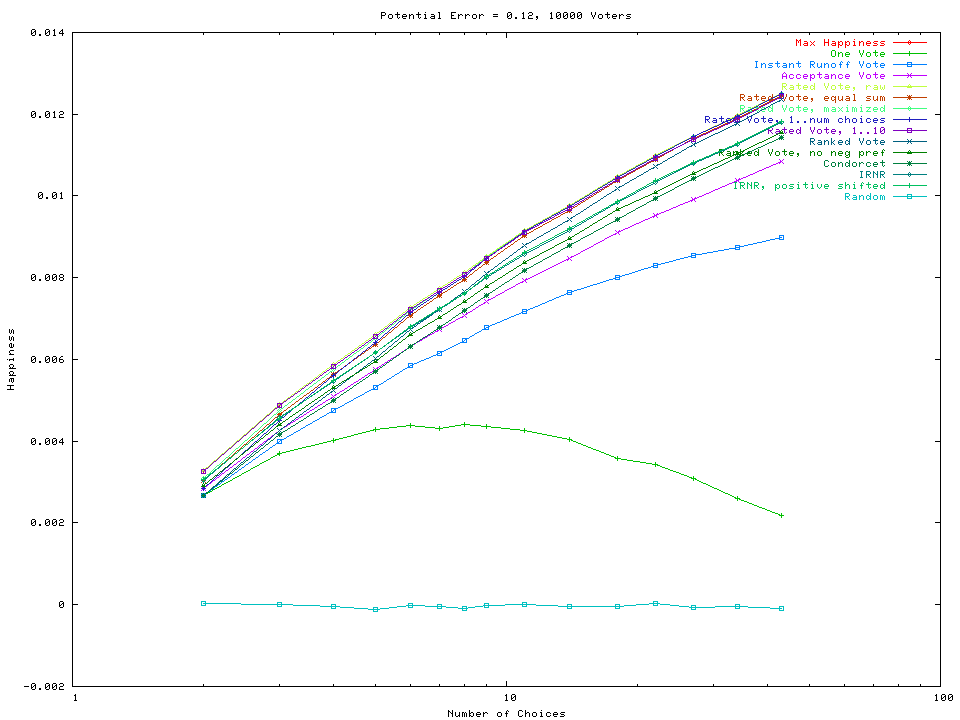
Instant Runoff Voting (IRV) has gained some traction and gotten some attention, but is a severely suboptimal election method. This page aims to illustrate IRV's shortcomings when compared to other methods and counter misleading Fear Uncertainty and Doubt being spread as pro-IRV arguments.
Yes, IRV is better than nothing. It's better than tired old pick-one voting. But that's about all it's better than...
The graph below shows an assortment of election methods run in simulated elections of 10000 voters and various number of candidates to choose from. Increased happiness is on the virtical axis. In general, as there are more choices, there's a better chance of there being some choice that makes more people happy, and so overall happiness rises. If you can only cast one vote this starts to fail above 7 choices as the populace gets fractured voting for their favorites. At the bottom is a control test experiment of picking a choice at random, which on average makes half the people happy, and half unhappy, for a total of zero.
Third from the bottom is Instant Runoff Voting. IRV doesn't get very good overall results because it only considers a small part of the votes at once, the top ranked choice. Because of this it can miss broadly supported compromise candidates. IRV doesn't benefit as much from having a wide selection of candidates to choose from. And as the next section shows, it can flat out get the wrong answer.

The diagrams below illustrate the decision reached by two election methods depending on where the center of public opinion lies. If the center of public opinion is closest to a candidate (diamonds) then the election should go to that candidate and the diagram gets colored to match. The plot of IRV results shows that IRV is capable of completely missing giving the election to the blue candidate even when the population is right there. In other regions the result is chaotic.
IRV has this irregular behavior because of how it transferrs lots of votes and disqualifies candidates. Subtle differences in the order of disqualification of candidates and the transfer of votes to other candidates can wind up swinging the election to substatntially different outcomes.
 |  |
| Instant Runoff Vote | Virtual Round Robin Election (Condorcet's Method) |
| more election diagrams | |
IRV requires all the ballots to be in one place at one time for counting (when someone's top active choice is disqualified, you have to go back and check their ballot to see how they would vote for their next most preferred). Or, for computer counting, the data from all the ballots has to be gathered in one computer. Hand counting techniques require physically moving piles of ballots around, and in a large election this could wind up requiring a fork lift.
VRR/Condorcet can be summed up from intermediate results, counted at precincts or counted by many people hand counting ballots. Hand counting techniques just need a sheet of paper to make tally marks on.
The simplistic method of Instant Runoff Voting, always counting only your top ranked choice (of candidates not eliminated in the rounds so far), is philosophically attractive to some people, but may not actually best serve your interests. One way of thinking about how IRV works is that if you were to assign numeric ratings to your choices, you might give a 1 to your fourth choice, 10 to third, 100 to second and 1000 to your favorite. If this huge difference in preference between choices accurately represents how you feel, IRV may represent you relatively well (but it can still make the generally wrong choice, as shown above). Other methods tend to have a more uniform effective distribution of preference between the choices. A second or third choice obviously isn't as preferred as the first choice, but out of several candidates, second or third choice is probably still good or ok. IRV won't consider these lower ranked choices at all, and may have prematurely disqualified them if they didn't get enough first-choice vote.
There's a more general rumor applied to IRV and other rankings methods in general that says you should only vote for a top choice, or a top few, and not give any ranking to lower preference choices so that they will not be aided in any way. For any decent election method, and even IRV, your lower ranking choices will only be relevant if your higher ranking choices are losing anyway. Sometimes, that's just Democracy, and you don't get what you want. A fully ranked ballot at least gives you some say in which of the other ones gets elected. You might not get what you want, but you might get someone less bad than worst.
Similar to the don't-fully-rank FUD above, this claims that there's a possibility of violating the 'one person one vote' principle of democracy. At the very least there is an equal potential for every voter to vote by fully filling out their ballot. There is an equal potential for everyone to vote now, and half the people don't cast any vote. It could be further considered that your 'vote' is not simply the traditional statement of who your favorite is, but a statement about all the choices. Suppose there are ten choices. With the old pick-one ballot, you get to vote YES on one choice and have to vote NO on the rest. With an approval ballot, you can vote YES on as many as you like. With a rankings ballot, you can vote 1st, 2nd, 3rd, etc. on the ones you like and leaving some blank means "I don't know" or "I don't care" - which is an expression about that choice. Everyone who shows up and votes is saying something about all the choices, and casting an equal weight ballot as anyone else. It's then important that the ballot be structured reasonably to get as much expression out of the voter as can easily be gotten, and it is important that the counting method use this data as best as possible so as to satisfy the will of the people.
Please link to this page as https://bolson.org/voting/irv/
Comments? Email me
back to bolson's voting page